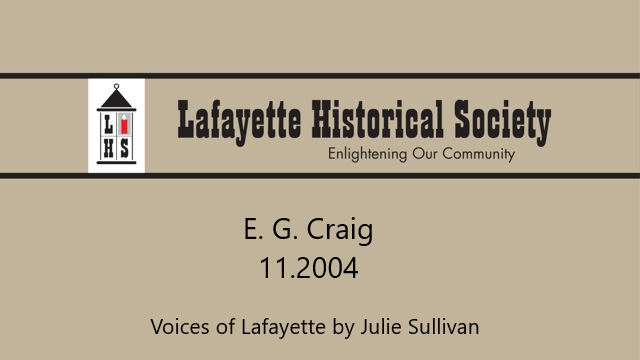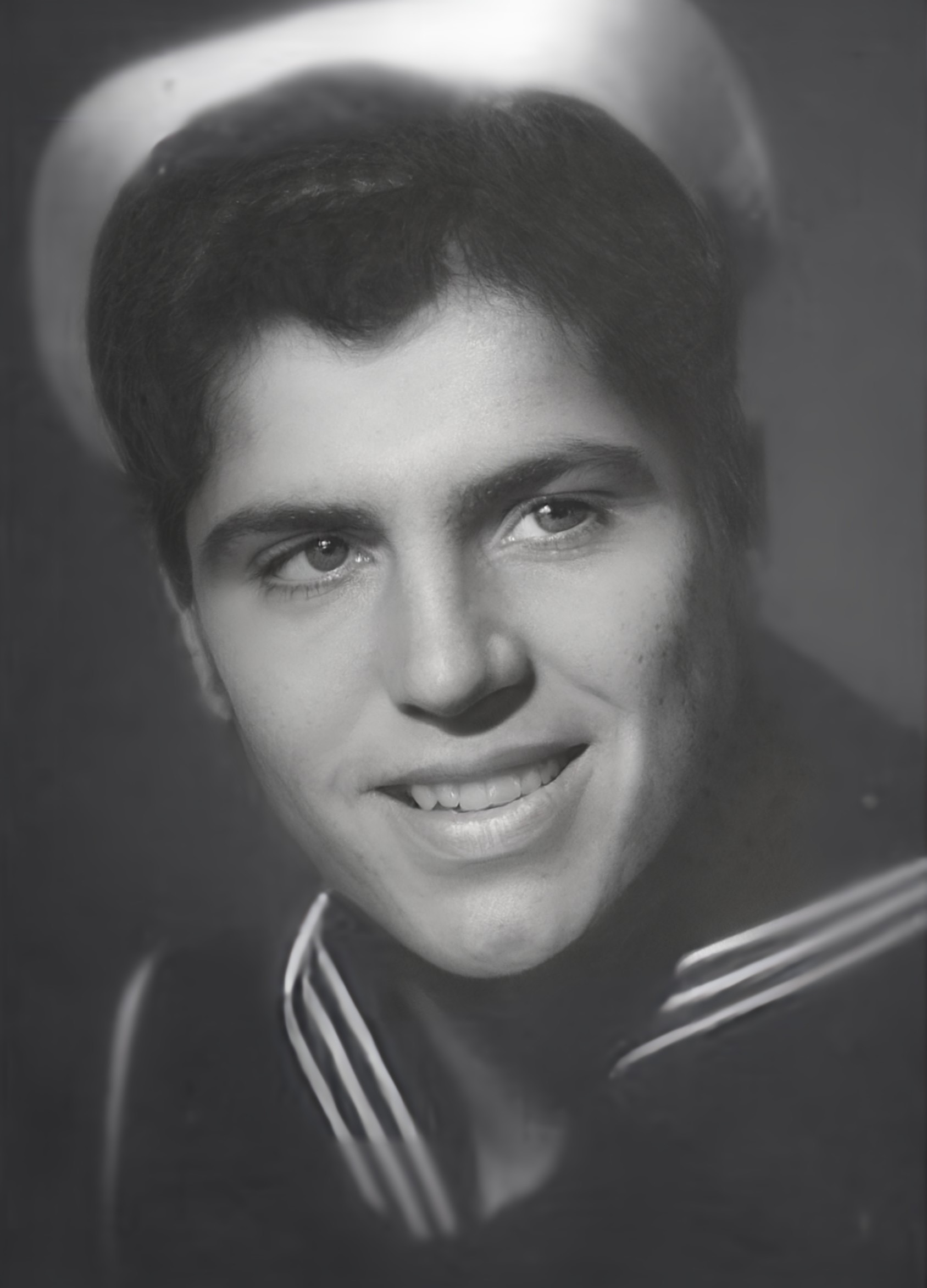Summary:
E.G. Craig was interviewed by Julie Sullivan in November, 2004. He moved to Lafayette and opened an architectural office in 1956. Over the next 4 decades he developed over 30 homes in the city, along with three office complexes. He practiced for 12 years before Lafayette became a city, then for three decades after. He says that being a city had the effect of slowing down development, which was a good thing for the city overall.
Oral History:
“Someone is eventually going to build a high-rise building in Lafayette.” That’s the prediction of E. G. Craig, a Lafayette architect for fifty years. E. G., or Craig as he prefers to be called, opened his first office in Lafayette in 1956, because “There were more clients here interested in contemporary architecture, and I had existing clients in nearby Montclair and Piedmont.” Today, at age 79, he has designed thirty Lafayette homes and three office complexes, the Campana Music building on Moraga Road, Oak Hill and Oak Hill West, and the Bonanza Building (at Mt. Diablo Boulevard and Golden Gate Way).
Although he calls himself semi-retired and a stroke in 2004 slowed him down, Craig still comes to the office each day. His office, located in Oak Hill West, a contemporary redwood-sided complex high among the trees above the intersection of Risa Road and Mt. Diablo Boulevard, is overflowing with architectural drawings and a lifetime of family photos. Craig originally bought two acres and built the first Oak Hill complex there in 1972, then sold to Ray Leal, the contractor. He later built the current complex on 2.2 adjacent acres.
The Craig family had its roots in Scotland. At age 12, Craig’s father stowed away on a cattle ship where he learned the butcher trade, and eventually landed in San Francisco. Craig’s maternal uncle, who was from the same village, also emigrated to San Francisco and deputized Craig’s father to meet his arriving sister. “He took one look at my mother and fell in love,” Craig says. “My father was the first one who came up with the idea of using a syringe to cure corned beef. He was a stern Scotsman.”
Craig was born in Oakland in 1926. When he was in fifth grade, the family moved and he was removed from private school to attend what he calls “a pretty rough public school.” He told his father he didn’t want to be called by his first name any longer (a name he prefers not to have in print), and at his uncle’s urging the boy was allowed to go by his last name. From age 14 Craig knew he wanted to be an architect, but his father was against it. ‘A butcher’s son can’t be an architect,’ his father insisted.
After high school graduation in 1944, Craig went into the Naval Air Corps. He trained at University of the Redlands, California. When the war ended in 1946, he left the service and was offered a basketball and football scholarship to Stanford, but again his father objected, calling sports players ‘bums,’ so Craig attended the College of Arts and Crafts in Oakland and an engineering school. He worked for architects in Orinda and Danville before going out on his own.
In 1964 Craig and his wife, Sheila, moved to Lafayette. Craig designed their home in Tanglewood, where he bought ten acres. He also built fifteen of the eighteen homes in the subdivision. “The owner agreed to sell me the land on the condition I obtained a building permit within one year. Otherwise the land reverted back to him. It took me nearly that long to get a building permit from the city.
“There was a creek running through the subdivision where our kids played,” he remembers. The Craigs have four sons, one daughter and seven grandchildren. “There were hundreds of undeveloped acres around our house to explore. Unknown to my wife or me, the kids took a raft down the creek all the way to Walnut Creek.” The Craigs later divorced, and now live separately in Rossmoor.
In 1972, he bought the property known as Oak Hill. About the same time he designed the Campana Music building. “We were required to put it at the back of the lot with parking at the front.” Because of the proximity of the creek at the back of the lot, Craig designed what he calls “a pole type building” with thick log columns supporting the upper story. In the early 1980’s Craig designed a condominium development on 340 acres near the Concord Pavilion for Ken Hoffman. “Most of my structures are very contemporary with 2,000 to 4,000 square feet,” he explains. “Originally, in Lafayette, a substantial home was around 2,500 square feet, but today that has increased to 4,500 to 6,000 square feet.” Craig is currently constructing a home for Lafayette resident Dick Holt.
Craig believes the biggest change in Lafayette was when it became a city in 1968. “The people who objected to the county rules ran the city. They said no to all kinds of development. The people who were already here didn’t necessarily want anyone else. Becoming a city kind of slowed things down for Lafayette in terms of development,” he says. “Overall that was good. Lafayette is not yet the place to be. Walnut Creek originally didn’t want high-rise office buildings either, but it kind of usurped Lafayette.
“The county planners originally suggested that Lafayette make the downtown four blocks square,” he remembers, “but that never happened. Usually grocery stores are on the perimeter of a town, but when (Russ) Bruzzone created the McCaulou’s shopping center, that kind of made a center for town. Originally it was a hill covered with eucalyptus trees about 40 feet high. Bruzzone cut them down and leveled the hill. Russ built shopping centers, and his brother did residential. Russ was the driving force. Major developers have to be the toughest guys in the world because of all the pressures in their job,” he adds with a note of respect.
Craig’s memories of early Lafayette include having lunch at Adolph Panfilli’s Seafood Grotto on Friday, because he loved their red chowder. “Panfilli said he’d only charge me fifty cents a day for all the chowder and bread I could eat if I’d come in on other days,” he says with a smile. “I ate there quite a lot after that.” Another favorite lunch spot in the 1950’s was the Tunnel Inn. “I remember Dr. Poston, the veterinarian, who had his office on Mt. Diablo Boulevard.” He especially remembers Petar’s restaurant when it was on the north side of Mt. Diablo Boulevard. “Back in the early 60’s when integration was just beginning,” he recalls, “Petar welcomed my chief draftsman who was African-American into the restaurant. I still miss Petar’s and the El Nido Rancho restaurant.
“I always liked Lafayette,” he adds. “It was fresh, open country. Lafayette really hasn’t grown all that much, and the spirit of Lafayette has remained the same.”
Excerpted from “Voices of Lafayette” by Julie Sullivan. This book is available for purchase in the History Room.



Love this interview. I arrived in Lafayette in 1954 with my parents. I knew EG, worked with his kids. I remember and knew all of his favorite spots. EG and Hirsch Morton were the best. Petar’s was so classy…sorely missed, such quality there.
One request; could you re-run the interview with Miler at Diamond K? The link did not work, I tried it so many times. I sold Miler my first drumset, which allowed me to buy an upgrade…immediately leading to an invitation to join the popular local garage rock band “The Radical 5″…funny stuff. Thank you LHS!
Greg Lahey
still in Lafayette
Not many of the Class of ’68 still living in Lafayette! Someday we’ll get together for a beer at the Roundup!